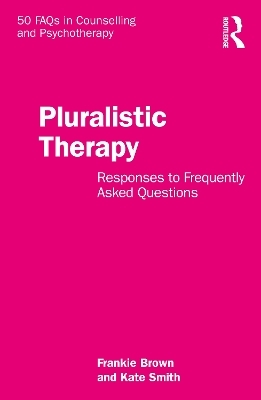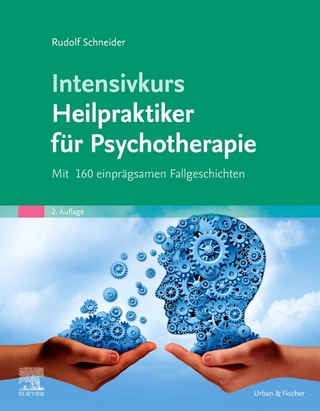
Pluralistic Therapy
Routledge (Verlag)
978-1-032-30567-7 (ISBN)
Pluralistic Therapy provides answers to the most important and common questions asked about the origins, principles, and practice of pluralism.
Written in an accessible style by experts in the field, the book provides the reader with a comprehensive understanding of the pluralistic approach in theory and practice, and builds on the contemporary developments in the field. The questions cover five areas, including an overview of pluralism, pluralism in practice, client factors, pluralistic developments outside of individual therapy, and critical questions about pluralism. The questions also cover some of the key challenges posed to the approach.
This book will appeal to a wide range of audiences, including therapeutic practitioners, researchers, and professionals interested in the application of the approach within mental health contexts. It will also serve to help professionals from non-therapy backgrounds such as mental health services, education, and social care, understand the nature of pluralistic work.
Frankie Brown, M.A., is a pluralistic counsellor and psychotherapist. Having previously lectured in pluralistic therapy at IICP, Dublin, she now works in private practice and as a school counsellor providing individual therapy and teaching inputs for students, teachers, and parents. Kate Smith, Ph.D., is a professor of Counselling at the University of Aberdeen, UK, and a pluralistic therapist. Having trained in 2007, she led the pluralistic practice steering group until 2021. Kate is the co-author of The Pluralistic Therapy Primer (2021).
SECTION 1 An overview of pluralistic counselling and psychotherapy 1 What is this ‘thing’ called pluralistic therapy? 2 What is the underlying philosophy behind pluralistic practice and why is it important? 3 Did we really need another approach? 4 There are lots of ways of integrating therapy – how is pluralism different? 5 What are the fundamental principles that guide pluralistic therapy? 6 Is pluralistic therapy an evidence-based practice then? 7 I’m confused between a pluralistic perspective and pluralistic practice, can you help? 8 How can someone trained in a single approach adopt a pluralistic stance? 9 Can you explain the language of pluralism? 10 What is the role of the therapist as a person in pluralism? 11 Why do pluralistic therapists focus so much on collaboration? 12 What knowledge is appropriate to use in the therapy room? SECTION 2 Pluralistic counselling and psychotherapy in practice 13 So where does a trainee start, and what skills and knowledge do they need? 14 How do pluralistic therapists create a formulation or treatment plan for clients, and why do they need one? 15 How do I create an effective timeline formulation with my client? 16 Why do pluralistic therapists work with client goals? 17 What is the difference between goals, tasks, and methods in practice? 18 What are task-lists and how do they work in practice? 19 What methods are used in pluralistic therapy and why? 20 How do pluralistic therapists monitor the process of therapy and whether the client’s goals are being met? 21 I know I have a block to using feedback measures, want to help me? 22 How do I work with client’s preferences if they don’t know what they are? 23 Why, and how, do pluralistic therapists use extra-therapeutic and cultural resources? 24 Can you tell me more about creative and artistic activities in pluralistic therapy? 25 What is the role of intuition and ‘felt-sense’ for practitioners in pluralistic therapy? 26 How can I be pluralistic and offer short-term counselling? 27 I’ve started pluralistically, how do I end pluralistically? 28 Can you give some examples of pluralistic work? SECTION 3 Working with specific client factors in pluralistic counselling and psychotherapy 29 Can I really collaborate and manage risk of self-harm and suicide in pluralistic practice? 30 Do clients actually want to know about the theoretical explanation for their problems? 31 Can you really ensure power is distributed between two experts? 32 Is a pluralistic approach really suitable for people living with severe and enduring mental health problems? 33 How can pluralism be adapted to working with young people? 34 Does pluralism address questions of inclusivity and equality? 35 How does pluralism align with other therapy approaches that aim to impact societal issues? 36 How does cross-cultural working enhance the pluralistic approach? SECTION 4 Pluralistic developments outside of individual counselling and psychotherapy 37 Right, I think I have this, but how do you maintain and develop what you can offer a client? 38 If I want to work pluralistically, do I need a pluralistic supervisor? 39 Is pluralism a concept relevant to other disciplines in mental health/therapy? 40 As an agency, how can we work pluralistically if some of our therapists are not pluralistic? 41 How can pluralism influence approaches to research in psychotherapy? 42 Where is pluralism going? 43 Pluralism is still so new, what support is out there if I want to work pluralistically? SECTION 5 Critiques of pluralistic counselling and psychotherapy 44 What happens if the therapist’s approach doesn’t meet the client’s needs in practice? 45 If you can do anything in therapy, can pluralistic clients become overwhelmed with choice? 46 You are asking a lot of clients; do they like it? 47 Is a collaborative therapy approach suitable for everyone? 48 How can outcomes be defined when client goals are so unique and personal? 49 What happens if the client can’t see or understand the problem, and what if it is a result of something outside their awareness? 50 Is a pluralistic therapist a ‘Jack of all trades and master of none’? Appendix I The ‘Ways Paradigm’ of Frankie Appendix II Which Measure and When?
| Erscheinungsdatum | 10.07.2023 |
|---|---|
| Reihe/Serie | 50 FAQs in Counselling and Psychotherapy |
| Zusatzinfo | 4 Tables, black and white; 5 Line drawings, black and white; 5 Illustrations, black and white |
| Verlagsort | London |
| Sprache | englisch |
| Maße | 129 x 198 mm |
| Gewicht | 540 g |
| Themenwelt | Medizin / Pharmazie ► Medizinische Fachgebiete ► Psychiatrie / Psychotherapie |
| ISBN-10 | 1-032-30567-3 / 1032305673 |
| ISBN-13 | 978-1-032-30567-7 / 9781032305677 |
| Zustand | Neuware |
| Haben Sie eine Frage zum Produkt? |
aus dem Bereich


